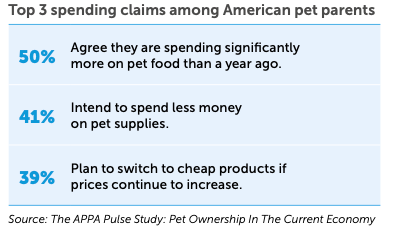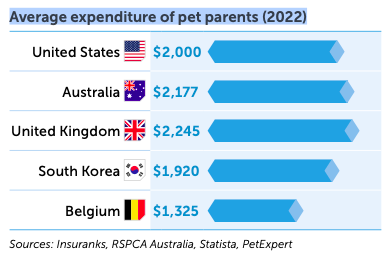The impact of inflation on pet parents’ wallets

More owners now admit to experiencing challenges with paying the bills for their pets. We analyze the way higher prices are changing the consumer mindset in different parts of the world.
The pet industry might seem recession-proof, but pet parents are currently facing an additional struggle which is burning a hole in many consumers’ pockets. While most of them say they still prioritize their pet’s well-being, the reality is that they are trading down in pack size or quality and looking for ways to pay vet bills.
Recession fears
A recent survey by the American Pet Products Association (APPA) concluded that 1 in 3 pet parents worry about pet expenses, with recession fears plaguing 69% of pet owners in the US. An additional 60% are concerned about their personal finances this year, in a country where pet products increased by 12% last year. The average inflation in 2022 was 8%, according to the US Bureau of Labor Statistics.
As many as 6 out of 10 respondents admit that they are spending less on non-essential items than a year ago. One-third of pet parents are concerned about the cost of having a pet in the current economic crisis, and 18% dread that they may have to give up their pet. Last December, 8% of pet parents in the US postponed getting a pet.
Finding a way to pay
Another research study, from the financial platform Credit Summit, concluded that 83% of American pet owners borrowed money at least once to pay for pet care. The findings, published last February, show that 31% of pet parents had to turn to payday loans and title loans (using their vehicles as collateral) to pay vet bills.
The survey also revealed that nearly 32% of the respondents had to decline treatment for their pet because they couldn’t afford it.
Online pet shop Pets4Homes found out that, in 2022, 18% of pet owners in the UK had pet care debts, 25% of them indicating that they won’t take their pet to the vet due to the high costs. Nearly 1 in 10 are even contemplating giving up their pet as expenses soar.
Trading down
A direct impact of high pricing is on consumer purchasing decisions. APPA states that there are no changes in brand fidelity trends in the US, with 57% of owners considering themselves very loyal to a specific brand when it comes to pet supplies. And most of them (66%) are committed to maintaining the pet’s current diet despite headwinds.
The Pets4Homes survey in the UK showed that 38% of respondents switched to cheaper pet foods. In 2022, accumulated inflation in pet supply prices in the UK reached 13.3%, according to the Consumer Prices Index. This is more than global consumer goods, which rose by 10.5% from January to December 2022.
Looking for smaller packages is a trend that is slowly spreading among pet parents. “Consumers are saving money in the short term instead of buying larger, bulk items that represent more pure value,” a Nielsen IQ study points out.
The recently published 2023 Global Consumer Insights Pulse Survey conducted by PwC Consulting concludes that 96% of general consumers are intending to adopt cost-saving behaviors over the next 6 months.
Insurance provider PetExpert reports that pet-related costs have skyrocketed in Belgium, with veterinary costs climbing by over 20% in 2022 alone. In the Netherlands, Dutch retailer Pets Place has said that 20% of their customers spent less money on their pets in the second half of 2022.
Lowering VAT in the UK?
The UK government has urged pet food manufacturers to support customers. “I make a plea to dog and cat food manufacturers to help their customers at this challenging time,” said Environment Secretary Thérèse Coffey during a Parliament hearing of the Department for Environment, Food and Rural Affairs in late February.
Ahead of the price rises, the option of lowering the tax applied to certain pet supplies such as food is on the table, with the aim to reduce the pressure on consumers. While the UK does not plan to change value-added tax (VAT) rates for specific products, Coffey asked representatives to let the government know what they can do “to make sure that our pets get fed”.
This follows the call from animal welfare charity Dogs Trust to remove the 20% VAT on pet food in a bid to help pet owners. According to the organization, this action could prove “critical to many pet owners, offsetting spiraling prices to keep pet food affordable”.
The actual numbers
American pet parents are believed to have spent roughly $2,000 (€1,879) on their pets last year. According to the insurance comparison platform Insuranks, half of them spent more on their pets than in previous years. The data reveals that the average spending on essentials – such as food, toys, litter and supplements – reached $110 (€103.4) per month.
In Europe, a recent Statista report concluded that owning a dog costs an estimated £1,875 ($2,245 / €2,117) a year in the UK. Belgians spend €1,250 ($1,325) per year on their companions, according to PetExpert.
In the Asia-Pacific region, South Korean consumers are spending an average of 208,000 ($160 / €150) a month on their pets. According to Statista, the cost of imported food increased the most. In Australia, it is believed that pet parents spend A$3,237 ($2,177 / €2,059) annually.

